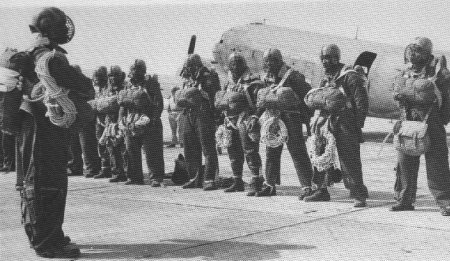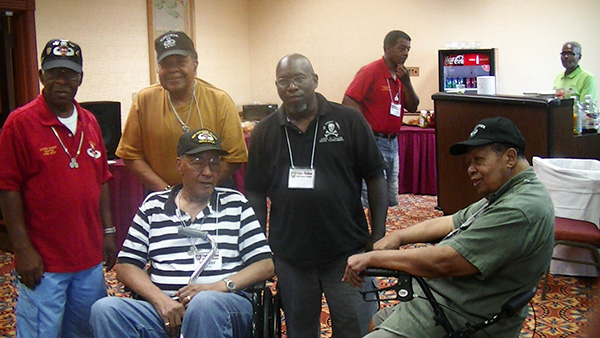The Triple Nickle
Today, a secret WW-II battle. The University of Houston's College of Engineering presents this series about the machines that make our civilization run, and the people whose ingenuity created them.
Ask anyone about black Americans in WW-II, and you hear about the Tuskegee Airmen, those courageous fighter pilots who guarded American bombers so well, late in the war. The story of another unit of black soldiers is far less well known because they functioned in secrecy. Their story began in 1944, when the Army agreed to form the 555th Airborne Battalion, a unit of black paratroopers.
Like the Tuskegee Airmen, the 555th (or Triple Nickle) had to fight prejudice and foot-dragging from all sides. They took only the best, and other units wouldn't let their best transfer into it. Passive resistance by the Army kept it below full strength. The Battle of the Bulge came and went that winter in Europe while black soldiers chafed to get into the 555th. Only as the war wound down in the spring did the unit finally reach battalion strength.
But now the Japanese had unleashed their secret weapon. Balloon bombs rode the jet stream all the way from Japan and landed randomly across western America. The military couldn't hide that completely, but they shrouded most of it in secrecy. The bombs actually killed only six people. A woman and five children were fishing near Bly, Oregon, and they chanced to find one of the bombs. It exploded as they tried to figure out what it was.
The one place the bombs were effective was in starting forest fires. The Forest Service had just introduced smoke-jumping in 1939 and was still working out its techniques. In May, orders reached the 555th. The battalion was to be trimmed to a company of 160 men. Only the best of the best were chosen. They were sent, not to Europe, but secretly to Pendleton, Oregon. There they were to be retrained as smoke-jumpers.
Much was different. The military train to come down in open terrain. Smoke-jumpers expect to land in trees, and they train to lower themselves to the ground when they do. The Triple began jumping into fires in the Summer of '45. The Jim Crow mentality was still alive in Oregon, but the community of pilots and firefighters was color-blind. They were all in it together.
So the men of the 555th made twelve hundred individual jumps into fires. As they honed this embryonic firefighting technique, they suffered burns, broken bones, asphyxiation, and the first smoke-jumping fatality. Malvin Brown landed in a tree near Roseburg, Oregon (where I finished high school two years later), and he fell to his death. I worked on a road survey crew in the virgin Douglas fir that he'd died to protect. I remember those noble 200-foot trees, and I shudder at the idea of trying to descend on a rope from a parachute tangled in the top branches.
The Triple saga makes a powerful story of swords to plowshares. These were some of the least-known WW-II heroes, serving their country, unrecognized, under truly battlefield conditions, and doing it without firing a shot.
I'm John Lienhard, at the University of Houston, where we're interested in the way inventive minds work.
(Theme music)
After this story surfaced as an NPR feature in March, 2000, I located the following source on the web: http://www.triplenickle.com. It, in turn, links to a great deal of historical background. I am grateful to Pat Bozeman, Special Collections and Archives at UH, for calling my attention to the NPR story and suggesting the topic. The following U.S. Army Photo from this site shows members of the 555th in their smokejumping gear, including "let down" ropes for getting to ground from a tree.

Note added in July, 2014: Sgt. Timothy McCoy, historian for the 555th Parachute Infantry Association, has recently provided a great deal of particularly poignant information about Pvt. Malvin Brown's death. Brown was a medic who had not completed his jump training. However, he was sent in as a replacement to fight a lightning-started forest fire just NW of Diamond Lake, Oregon, about 60 miles east of Roseburg. The day was August 6, 1945 -- the same day the first of two atom bombs were dropped on Japan.
Pvt. Brown was caught in a tree and attempted to lower himself on his rope. But he slipped and fell 140 feet to his death. He was taken to the Douglas Funeral home in Roseburg. (Click here for the Army's death notice for Brown, and click here for the Oregon certificate. The Army mistakenly placed his death in the Siskiyou Forest, far to the South west of Roseburg.) Click here to read several (all-too-brief) local news articles about the incident.
Below are four pictures very kindly provided by Sgt. McCoy:

This photo, taken in the airplane on the day Malvin Brown died, focuses on officers. Brown does not appear in the photo.

A photo of Malvin Brown's grave.

Survivors and friends of the 555th at the 2013 reunion: Striped shirt: Surviving 555th member Walter Morris, who died shortly after this reunion. Green shirt: Joe Murchison President of 555th Parachute Infantry Assn. Sgt. McCoy is in the middle, wearing a black shirt.
And I cannot look at that last photo, and think about this strange interlude of American history, without hearing Shakespeare:
We few, we happy few, we band of brothers;
For he today that sheds his blood with me
Shall be my brother; ...
And gentlemen in England now-a-bed
Shall think themselves accurs’d they were not here, ...
Note Added in January, 2015: More keeps coming to light about the Triple Nickle since I did this program in 2000. Now Chuck Sheley, Editor of SmokeJumper Magazine, writes to make several addenda and corrections. I list these here without correcting the text where it conflicts with the existing audio.
First of all, the 555th spelled Nickle differently from the Nickel coin. They were the Triple Nickle. And the Japanese balloon bombs only threatened to start forest fires, they never succeeded in doing so. The children killed by a balloon bomb had been picnicking, not fishing. He also points out that smoke-jumping techniques had been far better worked out by 1945 than my sources had suggested.
He has established better numbers for personnel and actions of the 555th. The unit was split, with 100 or so being sent to Chico, CA and the main of 200 or so being sent to Pendleton, OR. The 555th jumped into 15 fires and made 460 individual jumps - a third as many as my original sources reported. Finally, he has discovered that the unit's white pilots were not so color blind - that many made life harder for the jumpers of the 555th.